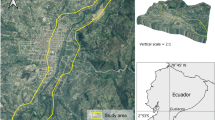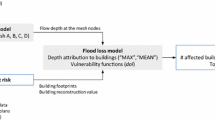Abstract
In loss estimation there is a spatial mismatch of hazard data that are commonly modeled on an explicit raster level and exposure data that are often available only for aggregated administrative units. Usually disaggregation methods that use ancillary information to distribute lumped exposure data in a finer spatial resolution help to bridge this gap. However, the actual influence of different mapping techniques and ancillary data on the final loss estimation has not been analyzed yet. In this paper three methods are applied to disaggregate residential building assets using two kinds of land use/land cover (LULC) data. The resulting disaggregated assets are validated and compared using census data of the residential building number on the community and constituency level. In addition, the disaggregated assets are taken to estimate residential building losses due to the flood in August 2002 in 21 municipalities on the River Mulde in Saxony, Germany. Losses are calculated with the help of four loss models. In general, disaggregation helps to decrease the error variance within the loss estimation. It must, however, be stated that the application of sophisticated disaggregation methods does not lead to significant improvements compared to the straightforward binary method. Therefore more effort should instead be put into the provision of high-resolution LULC data. Finally, the remaining uncertainties in loss estimation are high and demand further improvements in all modeling aspects.









Similar content being viewed by others
References
Apel H, Aronica GT, Kreibich H, Thieken A (2009) Flood risk assessments—how detailed do we need to be? Natural Hazards 49(1):79–98
Beyene M (2000) Abschätzung von Hochwasserschadenspotentialen—Ein Beitrag zum nachhaltigen Hochwasserschutz [Estimation of flood loss potentials—a contribution to sustainable flood protection]. In: Deutsch M, Pörtge KH, Teltscher H (eds) Beiträge zum Hochwasser/Hochwasserschutz in Vergangenheit und Gegenwart. Erfurter Geographische Studien 9:219–236
BKG GEODATENZENTRUM [Federal Agency for Cartography and Geodesy] (2005) ATKIS-Basis-DLM
Blong R (2003) A new damage index. Natural Hazards 30(1):1–23
Büchele B, Kreibich H, Kron A, Thieken A, Ihringer J, Oberle P, Merz B, Nestmann F (2006) Flood-risk mapping: contributions towards an enhanced assessment of extreme events and associated risks. Natural Hazards and Earth System Sciences 6:485–503
Chen K, McAneney J, Blong R, Leigh R, Hunter L, Magill C (2004) Defining area at risk and its effect in catastrophe loss estimation: a dasymetric mapping approach. Applied Geography 24:97–117
DLR–DFD [German Aerospace Center–German Remote Sensing Data Center] and UBA [The Federal Environment Agency] (2000) CORINE Land Cover 2000. Daten zur Bodenbedeckung—Deutschland [Data on land cover—Germany]. Oberpfaffenhofen, Berlin
Dutta D, Herath S, Musiake K (2003) A mathematical model for flood loss estimation. Journal of Hydrology 277:24–49
Eicher CL, Brewer CA (2001) Dasymetric mapping and areal interpolation: implementation and evaluation. Cartography and Geographic Information Science 28(2):125–138
Engel H (2004) The flood event 2002 in the Elbe River basin: causes of the flood, its course, statistical assessment and flood damages. Houille Blanche 6:33–36
EU (2007) Directive 2007/60/EC of the European Parliament and of the Council of 23 October 2007 on the assessment and management of flood risks. Official Journal of the European Union, L 288, 50:27–34
Fisher PF, Langford M (1995) Modelling the errors in areal interpolation between zonal systems by Monte Carlo simulation. Environment and Planning A 27(2):211–224
Gall M, Boruff BJ, Cutter SL (2007) Assessing flood hazards zones in the absence of digital floodplain maps: comparison of alternative approaches. Natural Hazards Review 8(1):1–12
Gallego J, Peedell S (2001) Using CORINE land cover information to map population density. Topic Report 6/2001 (Towards agri-environmental indicators). European Environment Agency, Copenhagen, pp 92–103
Ganoulis J (2003) Risk-based floodplain management: a case study from Greece. International Journal of River Basin Management 1(1):41–47
Grabbert J-H (2006) Analyse der schadensbeeinflussenden Faktoren des Hochwassers 2002 und Ableitung eines mesoskaligen Abschätzungsmodells für Wohngebäudeschäden [Analysis of parameters influencing loss during the flood event 2002 and development of a meso-scale estimation model for residential building damages]. Unpublished thesis, University of Potsdam
Hultgren T (2004) Raster-based automated dasymetric mapping. UCGIS Assembly 2004, 20–24 Oct. University of Maryland Conference Center, Adelphi
Hydrologic Engineering Centre (1998) HEC-FDA flood analysis system. User’s manual. CPD-72. USACE
HYDROTEC (2001) Hochwasser-Aktionsplan Angerbach [Flood action plan for the river Angerbach]. Teil I: Berichte und Anlagen. National Environmental Agency of the City of Düsseldorf, Aachen, Germany
HYDROTEC (2002) Hochwasser-Aktionsplan Lippe [Flood action plan for the river Lippe]. Teil I: Berichte und Anlagen. National Environmental Agency of the City of Lippstadt, Aachen, Germany
INFAS GEOdaten (2001) Das DataWherehouse. INFAS GEOdaten GmbH. Bonn. December
INFAS GEOdaten (2005) Das DataWherehouse. INFAS GEOdaten GmbH. Bonn. December
International Commission for the Protection of the Elbe River (ICPER) (2004) Dokumentation des Hochwassers vom August 2002 im Einzugsgebiet der Elbe [August 2002 Elbe River basin flood documentation]. ICPER, Magdeburg, Germany
International Commission for the Protection of the Rhein (ICPR) (2001) Atlas on the risk of flooding and potential damage due to extreme floods of the Rhine. ICPR, Koblenz, Germany
Kleist L, Thieken A, Köhler P, Müller M, Seifert I, Borst D, Werner U (2006) Estimation of the regional stock of residential buildings as a basis for comparative risk assessment for Germany. Natural Hazards and Earth System Sciences 6:541–552
Kron W (2005) Flood Risk = Hazard · Values · Vulnerability. Water International 30(1):58–68
Martin D, Langford M, Tate NJ (2000) Refining population surface models: experiments with Northern Ireland Census Data. Transactions in GIS 4(4):343–360
Meer U, Mosimann T (2005) Heterogenität von Bodenbasisdaten mittlerer Maßstäbe sowie Möglichkeiten zur Optimierung der Daten durch Disaggregierungsverfahren [Heterogeneity of basic soil data on the meso-scale and possibilities to optimize the data by disaggregation methods]. Department of Geography, University of Hannover, Hannover
Mennis J (2003) Generating surface models of population using dasymetric mapping. Professional Geographer 55(1):31–42
Merz B, Thieken A, Kreibich H, Apel H (2006) Quantifizierung ökonomischer Schäden für großräumige Schadensszenarien [Quantification of economic losses for large-scale loss scenarios]. Unpublished final Project Report, Geoforschungszentrum (GFZ), Potsdam
Merz B, Didszun J, Ziemke B (2007) RIMAX Risikomanagement extremer Hochwasserereignisse [Risk management of extreme flood events]. Geoforschungszentrum (GFZ), Potsdam
Messner F, Meyer V (2006) Flood damage, vulnerability and risk perception—challenges for flood damage research. In: Schanze J, Zeman E, Marsalek J (eds) Flood risk management. NATO Sciences Series. IV. Earth and Environmental Sciences, vol 67. Springer, Dordrecht
Messner F, Penning-Rowsell EC, Green C, Meyer V, Tunstall SM, van der Veen A (2006) Guidelines for socio-economic flood damage evaluation T9-06-01. UFZ, Leipzig
Meyer V (2005) Methoden der Sturmflut-Schadenspotenzialanalyse an der deutschen Nordseeküste [Methods of analysing surge damage potential at the German North Sea coast]. Dissertation, University of Hannover
Ministry of the Environment and Conservation, Agriculture and Consumer Protection of the German State of North Rhine-Westphalia (MURL) (2000) Hochwasserschadenspotenziale am Rhein in Nordrhein-Westfalen [Flood damage potentials at the river Rhine in North Rhine-Westphalia]. Final Report. MURL, Aachen
Mohaupt-Jahr B, Keil M (2004) The CLC 2000 project in Germany and environmental applications of land use information. In: Federal Environmental Agency (Umweltbundesamt) (ed) CORINE Land Cover 2000 in Germany and Europe and its use for environmental applications. Workshop. January 20–21, Berlin, pp 37–45
Munich Re (2007) Zwischen Hoch und Tief—Wetterrisiken in Mitteleuropa. Edition Wissen, Munich Re
Olsen JR, Beling PA, Lambert JH, Haimes YY (1998) Input-output economic evaluation of system of levees. Journal of Water Resources Planning and Management 124(5):237–245
Penning-Rowsell E, Johnson C, Tunstall S, Tapsell S, Morris J, Chatterton J, Green C (2003) The benefits of flood and coastal defence: techniques and data for 2003. Flood Hazard Research Centre. Middlesex University, London
Penning-Rowsell E, Johnson C, Tunstall S, Tapsell S, Morris J, Chatterton J, Green C (2005) The benefits of flood and coastal risk management. Middlesex University Press, London
Pichler A, Deppe T, Jackson V (2009) Risk assessment and risk management: effectiveness and efficiency of non-structural flood risk management measures. CRUE Research Funding Initiative Synthesis Report No I-2009. CRUE, London
Reese S, Markau H-J, Sterr H (2003) MERK. Mikroskalige Evaluation der Risiken in überflutungsgefährdeten Küstenniederungen—Abschlussbericht [Microscale risk evaluation of floodprone coastal lowlands—Final Report]. Kiel
Rodda HJE (2005) The development and application of a flood risk model for the Czech Republic. Natural Hazards 36(1–2):207–220
Rose A et al (2007) Benefit-cost analysis of FEMA hazard mitigation grants. Natural Hazards Review 8(4):97–111
Saxon Ministry of the Interior (SMI) (2002) Verwaltungsvorschrift des Sächsischen Staatsministeriums des Innern zur Behebung von Hochwasserschäden an Wohngebäuden [Administrative regulation on the compensation of flood damages of residential buildings]. SMI
Saxon Relief Bank (SAB) (2005) Schäden durch das Hochwasser 2002. Angaben aus der Fördermitteldatenbank [Damages of the flood 2002. Data from the Compensation Data Bank], February
Scawthorn C, Flores P, Blais N, Seligson H, Tate E, Chang S, Mifflin E, Thomas W, Murphy J, Jones Ch, Lawrence M (2006) HAZUS-MH flood loss estimation methodology. II. Damage and loss assessment. Natural Hazards Review 7(2):72–81
Statistisches Bundesamt (2004) [Federal Statistical Agency] 2004. Baupreisindizes November 2003. Statistisches Bundesamt. Fachserie 17, Reihe 4. Wiesbaden
Thieken AH, Petrow T, Kreibich H, Merz B (2006a) Insurability and mitigation of flood losses in private households in Germany. Risk Analysis 26(2):383–395
Thieken AH, Kreibich H, Merz B (2006b) Improved modelling of flood losses in private households. In: Kundzewicz Z, Hattermann F (eds) Natural systems and global change. Research Centre for Agriculture and Forest Environment, Polish Academy of Sciences, Poznan, Poland, and Potsdam Institute of Climate Impact Research, Germany, pp 142–150
Thieken A, Müller M, Kleist L, Seifert I, Borst D, Werner U (2006c) Regionalisation of asset values for risk analyses. Natural Hazards and Earth System Sciences 6:167–178
Ulbrich U, Brücher T, Fink AH, Leckebusch GC, Krüger A, Pinto JG (2003) The central European floods of August 2002: Part 1. Rainfall periods and flood development. Weather 58:371–377
van der Veen A, Logtmeijer C (2005) Economic hotspots: visualizing vulnerability to flooding. Natural Hazards 36(1–2):65–80
Wenkel KO, Schulz A (1999) Vom Punkt zur Fläche—das Skalierungs-bzw. Regionalisierungsproblem aus der Sicht der Landschaftsmodellierung [From point to area—the problem of scale and regionalisation in landscape modelling]. In: Steinhardt U, Volk M (eds) Regionalisierung in der Landschaftsökologie: Forschung–Planung–Praxis. B.G. Teubner, Stuttgart, Leipzig, pp 19–42
Wind HG, Nierop TM, de Blois CJ, de Kok JL (1999) Analysis of flood damages from the 1993 and 1995 Meuse flood. Water Resources Research 35(11):3459–3465
Acknowledgments
This study was part of the project MEDIS (Methods for the Evaluation of Direct and Indirect flood losseS), which was funded by the German Ministry of Education and Research (BMBF) in the framework of the research program RIMAX (RIsk MAnagement of eXtreme flood events; http://www.rimax-hochwasser.de) under contract number 0330688.
Author information
Authors and Affiliations
Corresponding author
Rights and permissions
About this article
Cite this article
Wünsch, A., Herrmann, U., Kreibich, H. et al. The Role of Disaggregation of Asset Values in Flood Loss Estimation: A Comparison of Different Modeling Approaches at the Mulde River, Germany. Environmental Management 44, 524–541 (2009). https://doi.org/10.1007/s00267-009-9335-3
Received:
Revised:
Accepted:
Published:
Issue Date:
DOI: https://doi.org/10.1007/s00267-009-9335-3




